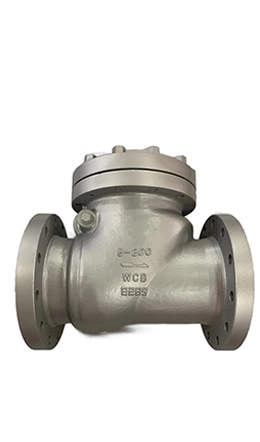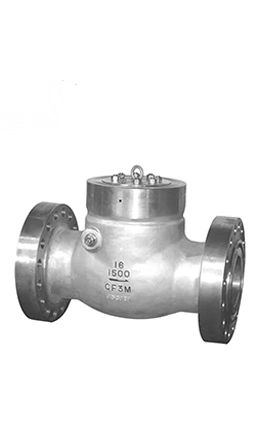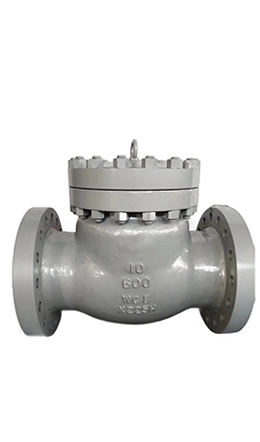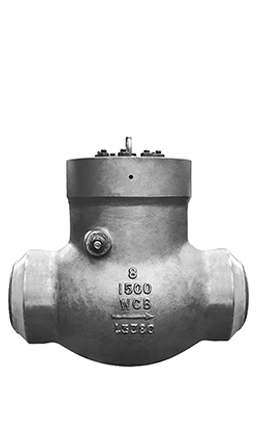A cast swing check valve allows forward flow and blocks the reverse flow. It provides a strong option for uni-directional homogenous flow applications. The cast swing check valve consists of a valve body, seat, and disc linked to the hinge. Upon encountering a specified flow rate, the disc rotates to a horizontal position, enabling forward flow. It returns to the valve seat when the flow stops to prevent backflow.




A cast check valve is a type of one-way valve designed to allow fluid (liquid or gas) to flow in one direction while automatically preventing reverse flow (backflow). Its body is manufactured through a casting process (e.g., sand casting, investment casting), making it robust and suitable for high-pressure, high-temperature, or corrosive environments.
1. Key Components
Cast Body: Made from materials like cast iron, carbon steel, stainless steel, or alloys. Provides structural strength and corrosion resistance.
Disc/Clapper: A movable component (hinged, spring-loaded, or gravity-operated) that opens or closes based on flow direction.
Seat: The sealing surface where the disc rests to block reverse flow.
Hinge Pin or Spring: Guides the disc’s movement (swing, lift, or tilting action).
2. Working Mechanism
Forward Flow (Open Position)
When fluid flows in the correct direction (indicated by an arrow on the valve body), the pressure of the fluid pushes the disc away from the seat.
The disc swings open (in swing check valves) or lifts vertically (in lift check valves), creating a clear path for fluid to pass through.
In spring-loaded designs, the spring compresses to allow flow.
Reverse Flow (Closed Position)
When flow stops or reverses, the fluid’s backpressure, gravity, or a spring forces the disc back onto the seat.
The disc seals tightly against the seat, blocking backflow.
The cast body’s rigid structure ensures the valve withstands pressure surges during closure.
3. Types of Cast Check Valves
Swing Check Valve:
Uses a hinged disc that swings open like a door.
Ideal for horizontal pipelines with steady flow.
Common in water supply, wastewater, and oil/gas systems.
Lift Check Valve:
Disc moves vertically (like a piston) to open/close.
Better for high-pressure or vertical flow applications.
Tilting Disc Check Valve:
Disc tilts at an angle for faster closure, reducing water hammer.
Used in steam or high-velocity systems.
4. Applications
Water/Wastewater: Prevents backflow in municipal water lines or treatment plants.
Oil & Gas: Protects pumps and compressors in pipelines.
Power Plants: Manages steam and condensate in boiler systems.
Chemical Processing: Resists corrosive fluids with alloy or stainless steel bodies.
5. Advantages
Durability: Cast construction handles high pressure/temperature.
Low Maintenance: No external controls – operates automatically.
Leak Resistance: Tight sealing minimizes backflow leakage.
Cast check valves are typically manufactured using materials selected for their durability, corrosion resistance, and suitability to specific operational conditions.
1. Cast Iron (Gray Iron)
Properties: Cost-effective, good machinability, adequate for low to moderate pressure.
Applications: Water systems, HVAC, and non-corrosive fluids. Not ideal for high-pressure or corrosive environments.
2. Ductile Iron (Nodular Iron)
Properties: Enhanced strength and flexibility compared to cast iron, resistant to impact and wear.
Applications: Higher-pressure water and gas systems, sewage systems, and industrial pipelines.
3. Bronze
Properties: Excellent corrosion resistance, particularly in seawater and mildly corrosive fluids.
Applications: Marine environments, plumbing systems, and oil refineries.
4. Carbon Steel
Properties: High strength, suitable for high-temperature and high-pressure conditions.
Applications: Steam systems, oil and gas pipelines, and power generation. Common grades include WCB, WCC, LCB.
5. Stainless Steel
Properties: Superior corrosion resistance, hygienic, and durable.
Applications: Chemical processing, food and beverage, pharmaceuticals. Grades like CF8 (304) and CF8M (316) are widely used.
6. Alloy Steels (Chrome-Molybdenum)
Properties: Heat-resistant, suitable for extreme temperatures.
Applications: High-temperature steam, petrochemical plants. Examples include WC6, WC9, and C5 alloys.
Super Alloys (Monel, Hastelloy, Inconel)
Properties: Exceptional resistance to corrosion, acids, and high temperatures.
Applications: Offshore drilling, chemical processing with aggressive media (e.g., sulfuric acid, chlorides).
